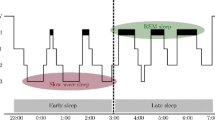Abstract.
Studies of regulatory mechanisms of sleep-wake rhythms have benefited greatly from mathematical modeling. There are two major frameworks of modeling: one integrates homeostatic and circadian regulations and the other consists of multiple interacting oscillators. In this article, model constructions based on these respective frameworks and their characteristics are reviewed. The two-process model and the multioscillator model are explained in detail. An appropriate mathematical abstraction is also shown to provide a viewpoint unifying the model structures, which might seem to be distinct. Recently acquired knowledge of neural regulatory mechanisms of sleep-wake rhythm has prompted modeling at the neural network level. Such a detailed model is also reviewed, and could be used to explore a possible neural mechanism underlying a pathological state of sleep-wake rhythm.
Similar content being viewed by others
Author information
Authors and Affiliations
Corresponding author
Rights and permissions
About this article
Cite this article
Nakao, M., Karashima, A. & Katayama, N. Mathematical models of regulatory mechanisms of sleep-wake rhythms. Cell. Mol. Life Sci. 64, 1236 (2007). https://doi.org/10.1007/s00018-007-6534-z
Published:
DOI: https://doi.org/10.1007/s00018-007-6534-z




